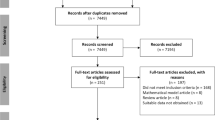Abstract
Four heterosexual pairs of three-year-old rhesus monkeys were either repeatedly separated from each other for 30-min or not separated. Prior to each separation, a transfer cage was displayed at the front of the cage to serve as a cue that the pair would be separated. After only a few trials, the animals displayed disturbance, particularly in the form of stereotyped pacingprior to the separation. Practical considerations related to laboratory methodology, a theoretical discussion concerning the fear of separation in monkeys and man, and the need for attention to individual differences in response to separation were emphasized.
Similar content being viewed by others
References
Brandt, E. M., C. Baysinger, &G. Mitchell, 1972. Separation from rearing environment in mother-reared and isolation-reared rhesus monkeys (Macaca mulatta).Int. J. Psychobiol. 2: 193–204.
Erwin, J., E. M. Brandt, &G. Mitchell, 1973. Attachment formation and separation in heterosexually naive pre-adult rhesus monkeys.Develop. Psychobiol. 6: 531–538.
——, 1971. Separation of juvenile rhesus monkeys of the same sex.J. Abnorm. Psych., 78: 134–139.
Hinde, R. A., Y. Spencer-Booth, &M. Bruce, 1966. Effects of 6-day maternal deprivation on rhesus monkey infants.Nature, 210: 1021–1023.
Maple, T., G. Risse, &G. Mitchell, 1973. Separation of adult male from adult female rhesus monkeys (Macaca mulatta).J. Behav. Sci. 1(5): 327–336.
McKinney, W. T., S. J. Suomi, &H. F. Harlow, 1972. Repetitive peer separations of juvenile age rhesus monkeys.Arch. Gen. Psychiat. 27: 200–203.
Mitchell, G., 1970. Abnormal behavior in primates In:Primate Behavior: Developments in Field and Laboratory Research, Vol 1,L. A. Rosenblum (ed.), Academic Press, New York. pp. 195–249.
——, 1967. Repeated maternal separation in the monkey.Psychol. Sci., 8: 197–198.
Rowell, T. E., 1962. Agonistic noises of the rhesus monkey.Symp. zool. Soc. Lond. 8: 91–96.
Sackett, G. P., G. A. Griffin, C. L. Pratt, & G. C. Ruppenthal, 1966. Mother-infant and adult female choice behavior in rhesus monkeys after various rearing experiences.Midwest. Psychol. Ass. Meet., Chicago.
Seay, B. M., E. W. Hansen, &H. F. Harlow, 1962. Mother-infant separation in monkeys.J. Child Psychol. Psychiat., 3: 123–132.
Van Hooff, J. A. R. A. M., 1967. The facial displays of the catarrhine monkeys and apes. In:Primate Ethology D. Morris (ed.), Weidenfield & Nicolson, London, pp. 7–68.
Author information
Authors and Affiliations
Additional information
Supported by NIH grants MH22253, HD04335, and RR00169, to Dr.Gary Mitchell; whose assistance is gratefully acknowledged.
About this article
Cite this article
Willott, J.F., McDaniel, J. Changes in the behavior of laboratory-reared rhesus monkeys following the threat of separation. Primates 15, 321–326 (1974). https://doi.org/10.1007/BF01791669
Received:
Accepted:
Issue Date:
DOI: https://doi.org/10.1007/BF01791669




